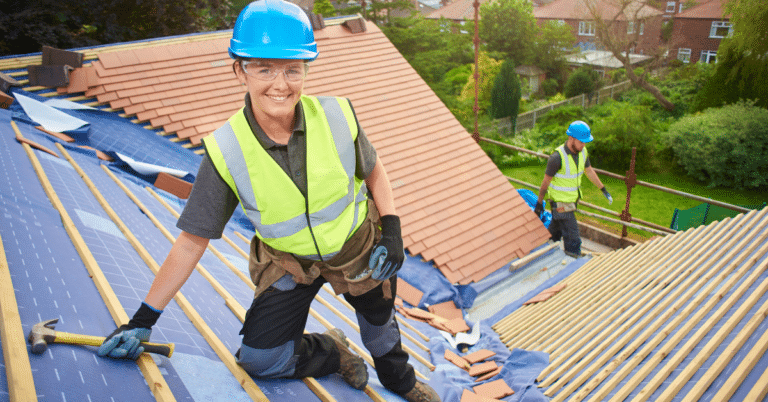Last Updated on January 23, 2025 by Jeffrey Calderon

Demystifying Construction to Permanent Loans for Homeowners
Construction to permanent loans can be a game-changer for aspiring homeowners.
The prospect of building your own home is thrilling, but the financial aspect? Not so much.
This is where construction to permanent loans come into play. They offer a lifeline in navigating the complex world of home financing.
These unique loan products are designed to ease your journey from vacant lot to dream home. But understanding them fully? That’s another story entirely.
Construction Loan Calculator
Table of Contents:
- What is a Construction to Permanent Loan?
- Demystifying Construction to Permanent Loans for Homeowners
- Qualifying for a Construction to Permanent Loan
- Applying for a Construction to Permanent Loan: A Comprehensive Guide
- Documents Required for Construction to Permanent Loans
- Closing Costs Associated with Construction to Permanent Loans
- Repayment Terms of Construction to Permanent Loans
- FAQs in Relation to Construction to Permanent Loans
- Conclusion
What is a Construction to Permanent Loan?
A construction to permanent loan, often known as a one-time-close or single close loan, provides an innovative financing option for homeowners and contractors involved in the home building process. This unique type of financing merges two separate loans – the construction-only loan and the permanent mortgage into one seamless borrowing solution.
The Dual Nature of Construction-to-Permanent Loans
In its initial phase, these loans function primarily as construction loans, providing funds during your property’s construction phase. During this stage, you’re building your dream home from scratch, and resources are needed for material costs and other expenses.
Once completed, however, the same loan converts automatically into what we call a conventional mortgage without any additional closing costs or paperwork required on your part. This conversion signifies the transition from making interest-only payments towards the total costs incurred during this period, to regular monthly repayments similar to those seen with traditional mortgages.
Navigating Your Financing Options: How it Works
This distinctive structure allows potential homeowners to borrow money directly towards project-related bills instead of receiving lump sum amounts at once, as typical traditional loans would do. Instead, lenders typically disburse money directly towards project-related bills, ensuring better control over fund usage while reducing risks associated with defaulting due to insufficient cash flow during ongoing construction projects. These projects can be quite expensive, especially if unforeseen issues arise mid-way, requiring extra financial input beyond the initial budget estimates provided by the builder before commencing work. This structure operates under agreed terms and conditions stipulated within the contract signed between the parties involved.
Details Regarding Construction to Permanent Loans
Explore construction to permanent loans for seamless home building. Learn about benefits, qualifications, and application steps in our guide.
Unveiling the Benefits of Construction to Permanent Loans
In the realm of home construction financing, one option stands out for its unique blend of benefits – construction-to-permanent loans. These loan types merge two distinct phases: a short-term construction loan and a long-term permanent mortgage.
A Glimpse at Lower Interest Rates
The structure in which lenders typically pay builders directly during your property’s construction phase often leads to reduced risk. This lowered risk can translate into lower interest rates compared with traditional mortgages or standalone permanent financing solutions. Additionally, borrowers make only interest-only payments throughout this period, making it financially manageable.
Fewer Closing Costs – A Financial Relief
When you’re building an existing home or initiating new home building from scratch, closing costs could pile up quickly under conventional methods like traditional mortgages where additional closing procedures are required after completion. However, with these innovative combined-loan options such as construction-to-permanent loans, all fees are consolidated into one transaction, thereby reducing total costs significantly over time.
An Efficient Loan Origination Process
Lenders generally charge origination fees twice if separate initial-construction and subsequent-mortgage loans were taken out instead. But when using this particular type that combines both stages together, they get charged once, hence saving money while simplifying administrative tasks associated with securing multiple individual ones simultaneously too.
Last but not least is flexibility regarding disbursement schedules based on project milestones rather than lump-sum distributions common under standard residential mortgages. This allows better cash flow management throughout the entire process while ensuring the low debt-to-income ratio remains intact, enhancing chances for approval even further, especially if having an excellent credit score too.
Construction-to-permanent loans offer homeowners a unique blend of benefits, including lower interest rates and reduced closing costs. This efficient loan option consolidates the construction phase and mortgage into one transaction, saving money and simplifying administrative tasks while offering flexibility in disbursement schedules for better cash flow management.
Qualifying for a Construction to Permanent Loan
Navigating the path towards construction-to-permanent loans might seem complex, but understanding the key factors that lenders typically consider can simplify this process. To be eligible for a construction-to-permanent loan, lenders typically assess one’s credit score, income steadiness and debt to income ratio.
Credit Score: The Key Player
Your credit score is an essential element in qualifying for any loan, including construction financing options like a construction-only loan or permanent mortgage. Lenders view these types of loans as riskier than traditional mortgages; hence, they require borrowers with excellent credit scores.
A high credit score not only boosts your chances of approval but also aids you in securing lower interest rates on your loan. Remember though – requirements may vary across different lending institutions, so it’s wise to do some research before applying.
Stable Income: A Reliable Safety Net
Lenders need assurance that you’re capable of making consistent monthly payments throughout both the home building phase and when the property’s construction completes and converts into conventional mortgage repayments after closing costs are considered. Therefore, having steady sources of income will significantly increase your odds of successfully obtaining this type of financing option.
If you’re building while still paying off debts from an existing home or other financial obligations, then demonstrating sufficient income becomes even more crucial.
The Debt-To-Income Ratio Factor
- The third pillar in assessing eligibility for such loans involves evaluating one’s debt-to-income (DTI) ratio, which measures how much total debt relative to gross monthly earnings exists.
- This figure provides potential lenders insight into whether applicants could handle additional debts post factoring in all associated expenses tied up with new lines of credits.
- Maintaining low DTI ratios, i.e., below 43% whenever possible, increases likelihoods since many creditors use similar thresholds during their assessment processes.
In essence, getting approved requires careful planning and preparation ahead. Aligning oneself appropriately against lender expectations sets individuals on course towards realizing dream homes via comprehensive yet manageable finance options available today.
Securing a construction-to-permanent loan isn’t rocket science. It’s all about showing lenders you’re a safe bet with a stellar credit score, steady income, and manageable debt-to-income ratio. Do your homework on lender requirements and plan ahead to set sail smoothly towards your dream home.
Applying for a Construction to Permanent Loan: A Comprehensive Guide
The journey towards building your dream home begins with understanding the financial landscape. Specifically, it involves comprehending how construction-to-permanent loans function as an essential part of this process. The Consumer Financial Protection Bureau (CFPB) provides useful insights on these financing options: The Consumer Financial Protection Bureau (CFPB).
In essence, construction-to-permanent loans involve securing funds during the initial stages and then transitioning into traditional mortgage payments once you have completed the construction phase.
Digging Deeper Into Your Finances
To successfully apply for such loans, you need to provide detailed information regarding your income status, existing debts, and credit score. Lenders typically seek borrowers who demonstrate excellent credit scores alongside low debt-to-income ratios, as these are indicative signs of reliable repayment capabilities.
- Builders of investment properties or second homes can expect additional scrutiny from lenders compared to those replacing their existing homes.
Your Home Building Plans Unveiled
- Lenders require comprehensive details about what exactly you plan on constructing. This includes providing blueprints or architectural drawings along with proposed budgets, as these are key elements in the loan application process.
- By providing these details, lenders gain insight into the total costs expected throughout every stage of the construction process. This ultimately helps determine how much money will be needed initially when applying for either permanent financing, such as conventional mortgages, or other forms of lending post-completion.
Navigating Interest Rates & Terms
Documents Required for Construction to Permanent Loans
The process of obtaining construction-to-permanent loans involves several steps, one of which is gathering and submitting the necessary documents. These documents help lenders assess your financial situation and determine if you’re a suitable candidate for such financing options.
Income Verification Documents
In order to ensure that borrowers can handle interest-only payments during the construction phase as well as full mortgage repayments once the loan converts into a permanent mortgage, lenders require proof of income. This typically includes W-2 forms or profit-and-loss statements if you are self-employed.
Bank Statements
Your bank statements serve multiple purposes in this context. Not only do they confirm your income claims but also provide insights about your regular expenses, savings habits, and overall money management skills – all important factors when it comes to home building finance considerations.
Tax Returns
Lenders will request tax returns from recent years as part of their assessment process too. Tax return data gives them an overview of how consistent your annual earnings have been over time – crucial information when evaluating whether you’re financially ready for taking on substantial costs associated with the property’s construction project like this.
Credit Report
- A credit report plays an integral role in any type of lending scenario, including applications related to securing funds through construction-to-permanent loans setup.
- This document reflects the borrower’s past borrowing behavior, thereby heavily influencing the lender’s decision-making concerning approval along with setting applicable interest rates.
- Bear in mind, an excellent credit score could potentially fetch lower rate offers. So make sure to review yours before starting the application procedure. Free Credit Reports available here.
Detailed Budget Estimate & Construction Plans:
The last set of documents required include detailed budget estimates alongside blueprints detailing every aspect of the proposed existing home improvement and new build projects planned. Lenders pay close attention to these details, ensuring the borrowed amount aligns perfectly against the scope of work outlined,
Securing a construction-to-permanent loan involves thorough document submission, including income verification and bank statements to assess your financial capacity. Tax returns provide an earnings overview while credit reports reflect borrowing behavior. Lastly, detailed budget estimates and construction plans ensure the borrowed amount aligns with project scope.
Closing Costs Associated with Construction to Permanent Loans
Construction-to-permanent loans, a popular financing option for home construction projects, have associated closing costs. These expenses are incurred at the end of your loan’s construction phase as it converts into a permanent mortgage.
The Inevitable Appraisal Fees
An appraisal fee is an unavoidable part of any loan process. It covers the cost of having a professional appraiser assess the value of your property once completed. The lender uses this evaluation in determining how much they can lend on your dream home.
Necessity of Title Insurance Fees
Title insurance fees serve as protection against potential legal claims challenging ownership rights over the property you’re building upon. This ensures that no one else has any legal claim or lien on your newly built residence.
Inclusion of Attorney’s Fees
In some jurisdictions, attorney’s fees may be necessary if local laws mandate real estate transactions to be overseen by attorneys. Even when not legally required, hiring an attorney to review all contracts and agreements could save future disputes or misunderstandings about terms and conditions during the construction process.
Miscellaneous Expenses: A Part and Parcel of the Transaction
- Apart from these specific charges tied up with securing construction-to-permanent financing options, there exist other miscellaneous expenses related directly towards finalizing the deal. Such overheads might include recording fees paid out to local government offices for registering new deeds, permits, public records; underwriting charges assessed by lenders for risk analysis; inspection costs borne at various stages throughout the home building journey, origination levies imposed for processing a fresh application, etc. Investopedia provides further insights into these additional closing costs.
- Note that while such extra upfront investment might seem daunting initially, especially compared to traditional mortgages where the borrower pays only once at the time of purchase, the transaction happens. But considering the total savings due to longer-term lower interest rates offered through such loans, combined with the flexibility of making interest
Navigating construction-to-permanent loans can feel like a maze of fees. From closing costs at the end of your loan’s construction phase, to appraisal and title insurance fees, attorney’s expenses, and various miscellaneous charges – it’s all part of the package. But don’t let these upfront investments scare you off; they’re often offset by long-term savings from lower interest rates
Repayment Terms of Construction to Permanent Loans
The terms for repaying construction-to-permanent loans are diverse, usually dependent on the lender’s policies. Most often, these involve either fixed or adjustable interest rates spread over 15 or 30 years.
Fixed Interest Rates and Their Benefits
A fixed-rate agreement means your monthly payments remain unchanged throughout the loan period. This stability allows you precise budgeting without fearing unexpected hikes in repayments due to fluctuating market conditions.
In contrast, an adjustable-rate mortgage (ARM) may initially offer a lower rate than traditional mortgages but can rise with time depending on economic trends. It’s crucial to factor this into future financial planning when considering financing options such as ARMs during home building projects.
Paying During The Home Building Phase
Lenders typically have varying approaches regarding payment structures during the property’s construction phase. Some allow borrowers to make interest-only payments at this stage, which aids in managing total costs while constructing their dream homes.
This implies that instead of paying both principal and interest simultaneously each month until completion, only accrued interests are paid off till conversion into permanent financing occurs after successful inspections within one year from the start date. This helps keep additional closing costs under control by efficiently utilizing available resources, making it a more appealing choice compared to other conventional methods prevalent in the industry today, especially if the borrower has an excellent credit score and other factors considered before granting approval by the respective authorities.
FAQs in Relation to Construction to Permanent Loans
What loans are referred to as construction-to-permanent loans?
Construction-to-permanent loans are a type of mortgage that finances the building of a home and then converts into a traditional loan after completion.
What is the relationship between a construction loan and a permanent loan?
A construction loan covers the cost of building your home. Once completed, it transitions into a permanent loan for long-term repayment.
What type of loan is best for construction?
The best type of loan for construction is typically the Construction-to-Permanent Loan due to its seamless transition from the build phase to homeownership.
What is permanent loan conversion?
Permanent Loan Conversion occurs when your short-term construction financing shifts into long-term mortgage payments upon project completion.
Conclusion
This unique loan product bridges the gap between building and owning, providing financial ease.
With benefits like lower interest rates and fewer closing costs, it’s an attractive option for many aspiring homeowners.
The qualification process requires good credit scores and sufficient income – but don’t let that deter you!
Application steps involve thorough documentation of your finances and property plans. It may appear intimidating, yet the exertion is worth it.
Closing costs are part of the package too – think appraisal fees, attorney’s fees among others. Yet another reason why understanding this loan type is crucial before diving in headfirst.
Last but not least: repayment terms. They vary by lender so do your research well! Whether fixed or adjustable interest rates over 15 or 30 years work best for you depends on individual circumstances.






